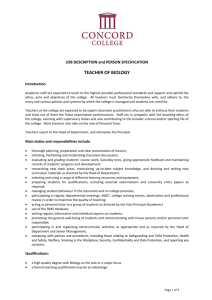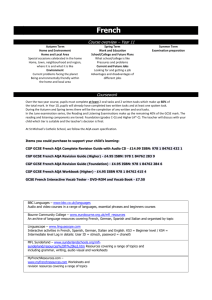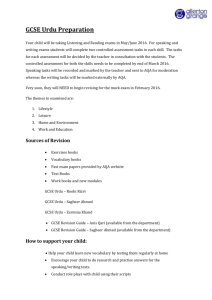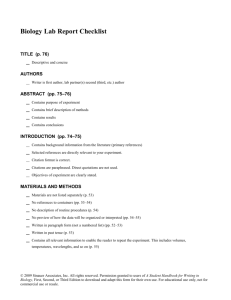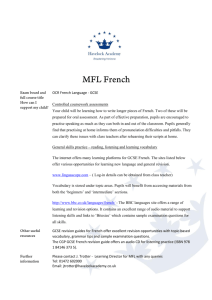AQA GCSE Biology: B1 Revision Answers
advertisement
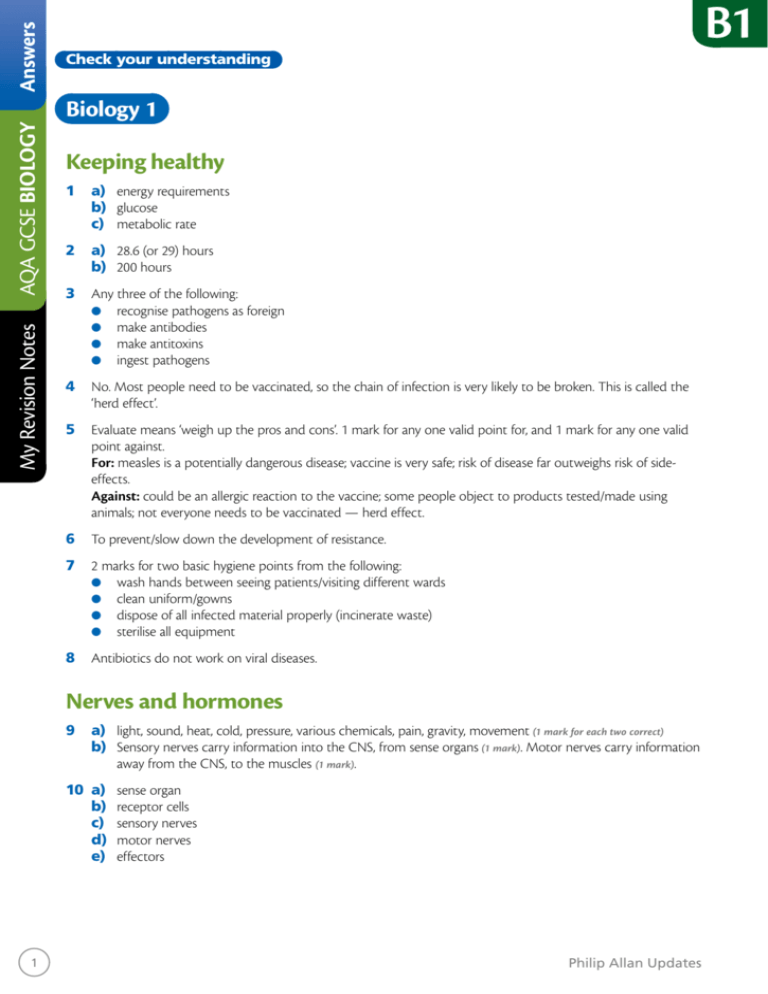
My Revision Notes AQA GCSE BIOLOGY Answers B1 Check your understanding Biology 1 Keeping healthy 1 a) energy requirements b)glucose c) metabolic rate 2 a) 28.6 (or 29) hours b)200 hours 3 Any three of the following: l recognise pathogens as foreign l make antibodies l make antitoxins l ingest pathogens 4 No. Most people need to be vaccinated, so the chain of infection is very likely to be broken. This is called the ‘herd effect’. 5 Evaluate means ‘weigh up the pros and cons’. 1 mark for any one valid point for, and 1 mark for any one valid point against. For: measles is a potentially dangerous disease; vaccine is very safe; risk of disease far outweighs risk of sideeffects. Against: could be an allergic reaction to the vaccine; some people object to products tested/made using animals; not everyone needs to be vaccinated — herd effect. 6 To prevent/slow down the development of resistance. 7 2 marks for two basic hygiene points from the following: l wash hands between seeing patients/visiting different wards l clean uniform/gowns l dispose of all infected material properly (incinerate waste) l sterilise all equipment 8 Antibiotics do not work on viral diseases. Nerves and hormones 9 a) light, sound, heat, cold, pressure, various chemicals, pain, gravity, movement (1 mark for each two correct) b)Sensory nerves carry information into the CNS, from sense organs (1 mark). Motor nerves carry information away from the CNS, to the muscles (1 mark). 10 a) sense organ b) receptor cells c) sensory nerves d) motor nerves e)effectors 1 Philip Allan Updates My Revision Notes AQA GCSE BIOLOGY Answers B1 11 a) sweating and exhaling/breathing out b) both lost in sweat c)due to diarrhoea 12 Highest just after a meal Lowest when fasting, or after exercise 13 a)pituitary b)ovaries c)oestrogen d) luteinising hormone 14 a) At ovulation/day 14 b)Because levels change throughout the month. A low reading could be from a time when levels are naturally low. You need to test at a time when levels will be at their highest. 15 Plants have no muscles. 16 Light from one side causes auxin to accumulate on the dark side. Auxin stimulates cell division and elongation. So growth is faster on the dark side. 17 Dandelions have wider leaves/a greater surface area. So they will absorb more toxin. 18 Because many seeds germinate in the dark/there is no light in soil. The use and abuse of drugs 19 a) b) c) d) side effects human tissue live animals clinical trials 20 Split the group randomly into two groups of 50/identical groups. Give one group the new statin. Give another group the most effective of the old statins. Double blind — neither the administrator nor the patients should know who is getting the new drug. Measure blood cholesterol levels at the start and throughout the trial. Look for the biggest fall in cholesterol levels. 21 a) They will feel happy. b) The brain stops making the natural hormone. c) They will feel unhappy. d) Being dependent on the drug — not being able to function without it. e)When they stop taking the drug they get withdrawal symptoms, so they need to take more to function normally. 22 Direct effects: obesity, liver damage, heart disease, violence (any two). Indirect effects: working days lost, family affected, financial problems, unwanted pregnancy (any two). 23 1 mark for any valid ‘pro’ comment: causes less damage than tobacco; supplies would be regulated/pure; legal dealers would not sell harder drugs; could be prescribed medicinally. 1 mark for any ‘con’ statement: causes mental illness; may lead to harder drugs. 2 Philip Allan Updates My Revision Notes AQA GCSE BIOLOGY Answers B1 Interdependence and adaptation 24 toxins, spines, bright coloration, armour, camouflage/crypsis etc. (any two) 25 light intensity, temperature, wind, humidity, soil nutrients (any two) 26 Any three from: l Hump on back stores fat without giving too much insulation. l Blood cells/blood can tolerate dehydration. l Nostrils close to keep out sand. l Splayed feet do not sink into the sand. 27 Greater combustion of fossil fuels (or name of source, e.g. car/aircraft engines); deforestation 28 Less photosynthesis; so less carbon dioxide is removed from the atmosphere. 29 Correlation in this case means a similar pattern. A rise in carbon dioxide levels correlates with a rise in temperature. Causation: do carbon dioxide levels cause the rise in temperature? Correlation is obvious, but causation is much more difficult to establish. Energy and biomass in food chains 30 a) An organism that can produce its own food by photosynthesis (e.g. plants). b) A plant eater/herbivore. c)A feeding level in a food chain/web. 31 detritus → earthworm → blackbird → cat grass → antelope → cheetah (1 mark for each) 32 Photosynthesise/produce their own food. 33 The biomass at each stage is less than it was at the previous stage. Waste material from plants and animals 34 a)Any three from: l Bacteria or fungi… l …release enzymes… l …that digest the surrounding material… l …and absorb the soluble products. b) Releases vital minerals such as nitrate and phosphate. c)bacteria and fungi 35 a)photosynthesis b)fossilisation c)respiration d)decay e)combustion 3 Philip Allan Updates My Revision Notes AQA GCSE BIOLOGY Answers 4 B1 Genetic variation and its control 36 a) Twins are usually brought up in the same house, so have the same environment. l They form a very small sample, so conclusions are not valid. b) l Environmental factors associated with bringing up twins apart may affect the results. 37 Adult cell cloning produces an identical copy of a particular individual — i.e. one that already exists. (1 mark) Embryo transfer makes many copies of a new individual that has never existed before. (1 mark) 38 They have the same/identical genes. 39 They can spray herbicides and kill the weeds without killing the crop. 40 Overuse of herbicides will affect the surrounding areas. Many wild flowers will die; so might the insects/other animals that depend on them. Evolution 41 Any suitable suggestion, for example people who have lost limbs do not have children with missing limbs. 42 Darwin’s theory states that variation is present from birth. Lamarck’s theory states that variation/adaptation can be acquired during the lifetime of an individual. or Lamarck’s theory applies to individuals, while Darwin’s theory focuses on populations. 43 Any four from: l There is variation in the rat population. l Some rats are born with the resistance gene (or allele). l Those with that gene survive and reproduce. l These pass their genes onto the next generation. l So in the next generation there will be more resistant rats. Philip Allan Updates My Revision Notes AQA GCSE BIOLOGY Answers B2 Check your understanding Biology 2 Cells and simple cell transport 1 a)mitochondria b)chloroplast c)ribosomes 2 a) Mitochondria provide energy for contraction. b) Chloroplasts are the site of photosynthesis. c)Ribosomes are the site of protein synthesis. 3 a)true b)false c)true d)false 4 a) Some substances can get through, but not all. b)The cell membrane (the wall is freely permeable). 5 Any two from: l thickness of membrane/diffusing distance ltemperature l concentration difference Tissues, organs and organ systems 6 a) mouth/tongue/teeth/oesophagus/stomach/small intestine/large intestine/liver/pancreas/salivary glands b)heart/arteries/veins/capillaries c) brain/spinal cord/eye/ear/nerves d)ovary/uterus/oviduct/cervix/vagina 7 mitochondrion, cell, tissue, organ, system, organism, population Photosynthesis 8 Any two from: l makes food l makes oxygen l only route for energy into ecosystem 9 carbon dioxide + water (in presence of) light energy, chlorophyll → glucose + oxygen 10 Starch is insoluble. 11 a)(iii) b)(v) c)(i) d)(ii) e)(vi) f)(iv) 5 Philip Allan Updates My Revision Notes AQA GCSE BIOLOGY Answers 12 a) Measure the amount of oxygen given off (as bubbles) over time. b) The factor you listed in a). c)temperature d) Any three from: l light intensity l carbon dioxide lminerals lwater e)1 mark for x-axis labelled as temperature; 1 mark for y-axis labelled as rate; 1 mark for line, rising at first, then falling (after 40°C or so) 13 Low light intensity/short days and low temperatures for most of the year. Organisms and their environment 14 a) One close to car exhaust fumes/near road; one further away. More air pollution equals less lichen. b)They must be placed at random. Divide whole area up into numbered parts, and then use a random number generator (or similar idea). c)One site is not enough/may be unrepresentative (1 mark). Need more than one to improve reliability (1 mark). Proteins — their functions and uses 15 We digest the protein into amino acids. We then absorb the amino acids. The amino acids are then assembled in a different sequence/order to make our proteins. 16 protein, active site, substrate, specific, denatured 17 a) b) (i) (ii) (i) (ii) (iii) The amount of substrate decreases and the amount of product increases. The amount of substrate and the amount of product remain the same. Faster reaction, so steeper, but levelling off earlier at the same height. Same gradient, but going twice as high. No activity — the enzyme is denatured. 18 a) salivary gland, pancreas, intestine wall b) pancreas, intestine wall c)Proteins are digested into chains of amino acids (1 mark). These short chains are digested into individual amino acids (1 mark). d) They are absorbed into the blood (where they pass to the liver). 19 They cannot emulsify fats (turn large lipid droplets into smaller ones). So lipid digestion is slower/less efficient. 20 a)(iii) b)(i) c)(vi) d)(v) e)(ii) f)(iv) 21 They remain active/remove stains over a range of temperatures/work even in hot washes. The enzymes are not denatured by high temperatures. 6 Philip Allan Updates B2 My Revision Notes AQA GCSE BIOLOGY Answers 22 Advantage — effective at low temperatures, which saves money on fuel. Disadvantage — enzymes are specific (may not remove all stains); enzymes in waste water may harm the environment. 23 Fructose is sweeter, so you need less, which means fewer calories. Aerobic and anaerobic respiration 24 Measure their rate of oxygen consumption (or heat production, which is much harder). 25 To build up glycogen stores (1 mark), so that there is more energy/glucose for the race (1 mark). 26 Any two from: l There is a build-up of lactate. l Which is painful/interferes with muscle contraction. l So the athlete cannot continue beyond this distance at full speed. Cell division and inheritance 27 gene, chromosome, nucleus, cell, tissue 28 a) Four cells, each with half the chromosome number of the original cell, and all genetically different. b)17 29 They only make more skin cells — they cannot make different types. 30 Ethical problems — embryos are destroyed when stem cells are extracted. Some could see this as a waste of human life. 31 Any five from the following: l All female body cells have XX/two X chromosomes l So all the ova carry an X chromosome. l All male body cells have XY. l So half the sperm carry an X, and half carry a Y. l If an X-carrying sperm fertilises the egg, a girl results. l If a Y-carrying sperm fertilises it, the result is a boy. 32 a) Phenotype is the observable features of an organism. Genotype is the alleles the organism possesses. b) long coat c) short-coated parent ll (1 mark); long-coated parent either Ll or LL (2 marks) d) Gametes L l L LL Ll l Ll ll 1 mark for diagram/table/grid with right idea/structure 1 mark for correct gametes 1 mark for correct genotypes e)Breed the unknown ferret with a short-coated (double recessive, or ll ferret) (1 mark). If the offspring are all long coated, the unknown was LL (1 mark). If half have long and half have short coats, the unknown was Ll (1 mark). 33 a)recessive b) 25%, or 1 in 4 c) genetic test d) Terminate the pregnancy, or carry on with the pregnancy in the light of advances in medicine. 7 Philip Allan Updates B2 My Revision Notes AQA GCSE BIOLOGY Answers 8 B2 Speciation 34 Any four from: l There was variation in the rabbit population. l Some were naturally immune to the virus/had the alleles for resistance. l Those individuals survived. l And passed their resistance alleles onto the next generation. l So in the next generation there were more resistant individuals. Philip Allan Updates My Revision Notes AQA GCSE BIOLOGY Answers B3 Check your understanding Biology 3 Movement of molecules in and out of cells 1 large surface area, thin membranes, good blood supply 2 Seawater has a high salt concentration, which will draw water out of the blood by osmosis and make dehydration worse. 3 The lungs are attached to the ribcage and diaphragm (1 mark). The intercostal muscles and diaphragm contract (1 mark), increasing the volume in the thorax (1 mark) and lowering the pressure (to below atmospheric) (1 mark). So air flows in (1 mark). 4 a) We breathe more deeply, and more frequently. b)Any three from: l Muscles respire. l So they need more oxygen. l And they make more CO2. l So gas exchange must be faster. 5 Transpiration is the loss of water from the leaves/stomata of a plant. 6 Any two from: l still air/no wind lhumid lcold 7 They absorb nitrate via the roots. Transport systems in animals and plants 8 a) b) c) d) vena cava — deoxygenated, low pressure pulmonary artery — deoxygenated, high pressure pulmonary vein — oxygenated, low pressure aorta — oxygenated, high pressure 9 There is more time for diffusion/exchange of materials. 10 No, the pulmonary artery carries deoxygenated blood. 11 There is less chance of an artery being cut. Rapid blood loss would be dangerous/fatal. 12 They have no nucleus, so are not able to repair themselves and therefore have a short life. 13 Each red cell carries less oxygen. So having more red cells compensates for this/allows more oxygen to be carried. 14 Less blood loss; less chance of infection. 15 Made by photosynthesis. 9 Philip Allan Updates My Revision Notes AQA GCSE BIOLOGY Answers 16 Similarities (any two): l Both are transport tissues. l Both are made of long, cylindrical cells. l Both carry large volumes of fluid. Differences (any 2): l Xylem is dead, phloem is alive. l Xylem carries water and minerals, phloem carries dissolved sugars. l Xylem just carries fluid up the stem. Phloem can transport substances up or down the stem. Homeostasis 17 a) You make a large volume of dilute urine. b)You make a small volume of concentrated urine. 18 Active transport can reabsorb all the glucose/can move glucose against a concentration gradient. Diffusion would just reabsorb half/reach equilibrium. 19 There are no (red blood and white blood) cells in it. 20 water, salt, urea (2 marks for three, 1 mark for two) 21 a) In the brain/thermoregulatory centre. b)Any two from: l Shivering — movement of muscles creates heat. l Less blood flow to the skin surface — warm blood is kept deeper in the body. l Hairs stand erect — trapping an insulating layer of air. (1 mark for each response, 1 mark for the explanation) 22 a)A are warm blooded, so the core temperature stays constant whatever the external temperature (1 mark). B are cold blooded, so the body temperature is the same as the external temperature (1 mark). b)chicken and dog 23 Glucose is a simple sugar. Glycogen is a large complex storage molecule consisting of thousands of glucose molecules. Glucagon is a hormone that stimulates the breakdown of glycogen. 24 Any two from: lrespired l converted into glycogen l converted into lipid 25 a) b) c) d) ate something containing glucose or starch exercised, or had insulin injection decrease, could become too low decrease, could become too low Humans and their environment 26 Any four from: l Algae absorb pesticide. l Water fleas eat many algae, and absorb all the pesticide. l This is repeated up the food chain. l The pesticide levels are amplified. l They become toxic to perch/herons. 10 Philip Allan Updates B3 My Revision Notes AQA GCSE BIOLOGY Answers B3 27 a) Can be broken down by microbial/bacterial action. b) Carbon dioxide and methane. c)They are greenhouse gases. 28 So that populations of forest animals can mix and breed. The corridors prevent isolated populations, and therefore inbreeding. 29 Any two from: l Fewer trees means less photosynthesis. l So less carbon dioxide is removed from the air. l Burning creates carbon dioxide. 30 Any three from: l Learn from our mistakes. l The forest is more valuable to you as it is. l (Eco) tourists will come. l You can log in a sustainable manner. l So that the forest regenerates. l Leave something for your children. 31 1 = b) acid rain 2 = c) global warming 3 = d) sewage 4 = a) deforestation 32 Any two anaerobic situations/activities: l digestion in cows l rice fields l wetlands/peat bogs l biodegradation in landfill sites 33 Any three from: l The thicker the arrow, the greater the amount of energy. l Most energy is lost in faeces. l Some energy is lost in respiration. l Least of all/very little is left to make new tissue. 34 So they use less energy in respiration (1 mark) to maintain body temperature (1 mark). 35 a)Reduce the number of levels in the food chain (1 mark). Restrict energy loss from food animals by restricting movement (1 mark). Keep in heated conditions, so less energy is wasted keeping warm (1 mark). b)Positive: can feed more people on the same amount of land. Negative: animal welfare issues/quality of life. Overcrowding also increases the spread of disease. 36 Any two from: l Growing plants for us to eat is more efficient than growing plants to feed animals for us to eat. l So in a fixed area of land, more people can be fed if we grow plants. l The fewer steps in the food chain, the fewer chances there are for energy to be lost. 11 Philip Allan Updates



